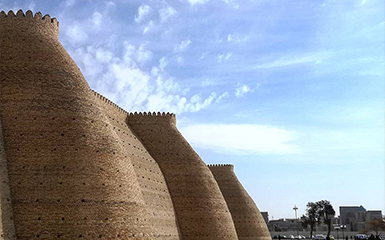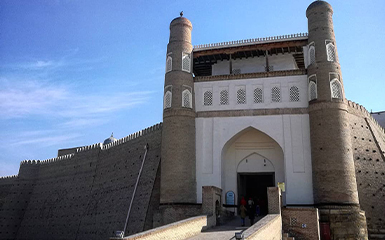Bahauddin complex
Char Minar
Lyab-I Hauz complex
Poi Kalan complex
The Ark Citadel
Bolo Haouz Mosque
Kalan Minaret
Islam Khodja complex
Itchan Kala
Kalta Minaret
Kunya Ark
Kutlugmurat Anak
Alla Kuli Khan
Muhammad Rahim Khan
Muhammed Emin Khan
Pahlawan Mahmud
Tash Hauli
Juma Mosque
Andijan
Muynak
Rabati Malik
The Ark is a citadel in the Uzbek city of Bukhara. It served as the residence and seat of government of the khans and emirs of Bukhara.
The citadel is located in the historic centre of Bukhara in the northwest of the old town on the Registan on an artificially raised hill about 20 meters high. Opposite the citadel to the west is the Bolo Hoauz Mosque. To the east of the citadel lies the Zindan, the former prison of Bukhara. To the south of the Ark are the Hodja-Zaynuddin complex and the Poi Kalan building complex.
The time when the Ark was built is unknown. According to legend, Siyavash is considered to be the builder of the citadel. His grave is said to have been at the east gate. Excavations revealed traces from the 4th century BC.
Over the centuries the citadel has been destroyed and rebuilt several times, most recently under the Shaybanids. Here was not only the ruler's palace, but a "city within the city" with state institutions such as mint, apartments of high public servants, barracks and farm buildings such as storehouses, workshops, stables, etc.
When Bukhara was conquered by the Red Army in 1920, the wooden buildings went up in flames, and some were rebuilt according to historical plans.
The citadel extends over an area of about four hectares. It is surrounded by a massive fortress wall. Most of the site is in ruins.
A ramp leads from the Registan to a gate structure with two round corner towers, a barred gallery above the gate and an open gallery supported by columns above. Behind the entrance, a tunnel leads past the former dungeon to the surface of the citadel.
The ruler's palace is a simple brick building. There is a museum for regional studies in it. The throne room is a paved courtyard, only some of the pillars supporting the roof have been preserved from the former roof.
To the north of the palace is the Djami or Djuma mosque (Friday mosque), which was built in 1712 and is open on three sides under Iwan. The open area was used as a summer mosque.


